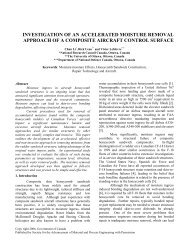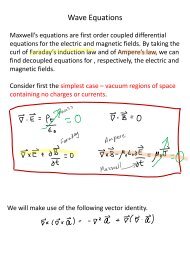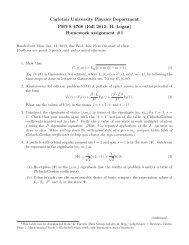Assignment 7 [pdf] - Department of Physics - Carleton University
Assignment 7 [pdf] - Department of Physics - Carleton University
Assignment 7 [pdf] - Department of Physics - Carleton University
You also want an ePaper? Increase the reach of your titles
YUMPU automatically turns print PDFs into web optimized ePapers that Google loves.
<strong>Carleton</strong> <strong>University</strong> <strong>Physics</strong> <strong>Department</strong><br />
PHYS 4708 (Winter 2013, H. Logan)<br />
Homework assignment #7<br />
Handed out Wed. Mar. 27, 2013; due Wed. Apr. 10 by 5:00 p.m. at my <strong>of</strong>fice (Herzberg 2450).<br />
Problems are worth 5 points each unless noted otherwise.<br />
1. (Gasiorowicz 3rd ed. problem 19-1) Show that for a central potential V (r) = V (r), the matrix<br />
element Mfi = 〈φf|V |φi〉 (see Gasiorowicz Eq. (19-77)) can be written in the form<br />
Note that this is a function <strong>of</strong><br />
Mfi = 4π¯h<br />
V<br />
∞ sin r∆<br />
rV (r) dr. (1)<br />
0 ∆<br />
∆ ≡ | ∆| = 1<br />
¯h |pf − pi|, (2)<br />
and hence is invariant under ∆ → − ∆, which corresponds to θ → π − θ. This comes in handy<br />
when one deals with scattering <strong>of</strong> identical particles.<br />
2. Consider the scattering <strong>of</strong> two identical spin-1 particles. Following Gasiorowicz section 19-4,<br />
determine the appropriate form <strong>of</strong> the differential cross section for the states with total spin<br />
0, 1, and 2. In each case, work out the differential cross section at θ = π/2 in terms <strong>of</strong><br />
f(π/2), including the interference term. What is the differential cross section for unpolarized<br />
scattering, including the interference?<br />
3. (Gasiorowicz 3rd ed. problem 19-3) Consider the potential<br />
a<br />
V (r) = V0<br />
r e−r/a . (3)<br />
If the range parameter is a = 1.2 fm = 1.2 × 10 −15 m and V0 = 100 MeV in magnitude,<br />
what is the total cross section for proton-proton scattering at 100-MeV centre-<strong>of</strong>-mass energy,<br />
calculated in the Born approximation? Pay attention to the fact that the two protons are<br />
identical fermions. (This potential models scattering via the exchange <strong>of</strong> pions. It does not<br />
include the contribution from Coulomb scattering, which is a small effect anyway for the high<br />
centre-<strong>of</strong>-mass energy that we consider.)<br />
When calculating the total cross section, it’s convenient to write<br />
so that<br />
<br />
¯h 2 ∆ 2 = |pf − pi| 2 = 2p 2 (1 − cos θ) (4)<br />
<br />
dΩ = 2π<br />
d cos θ = ¯h2 π<br />
p 2<br />
<br />
d(∆ 2 ). (5)<br />
continued....
4. (Gasiorowicz 3rd ed. problem 19-4) Suppose the scattering amplitude for neutron-proton<br />
scattering is given by the form<br />
f(θ) = ξ †<br />
f (A + Bσp · σn)ξi, (6)<br />
where ξi and ξf are the initial and final spin states <strong>of</strong> the neutron-proton system. The possible<br />
states are<br />
ξi =<br />
χ (p)<br />
↑ χ(n) ↑<br />
χ (p)<br />
↑ χ(n) ↓<br />
χ (p)<br />
↓ χ(n) ↑<br />
χ (p)<br />
↓ χ(n) ↓<br />
ξf =<br />
χ (p)<br />
↑ χ(n) ↑<br />
χ (p)<br />
↑ χ(n) ↓<br />
χ (p)<br />
↓ χ(n) ↑<br />
χ (p)<br />
↓ χ(n) ↓<br />
and the scalar product <strong>of</strong> the Pauli spin matrices can be written as<br />
σp · σn = σ (p)<br />
z σ (n)<br />
z + 2 <br />
σ (p)<br />
+ σ (n)<br />
− + σ (p)<br />
− σ (n)<br />
<br />
+ . (8)<br />
Calculate the scattering amplitudes and corresponding total cross sections for all 16 initial<br />
and final spin combinations and make a table <strong>of</strong> your results.<br />
You can work in the representation where<br />
and<br />
σ+ = σx + iσy<br />
2<br />
=<br />
<br />
0 1<br />
0 0<br />
<br />
, σ− = σx − iσy<br />
2<br />
χ↑ =<br />
<br />
1<br />
0<br />
<br />
=<br />
, χ↓ =<br />
<br />
0 0<br />
1 0<br />
<br />
, σz =<br />
5. (Gasiorowicz 3rd ed. problem 19-6) Neutron-proton scattering, continued.<br />
<br />
0<br />
1<br />
<br />
<br />
1 0<br />
0 −1<br />
<br />
(7)<br />
, (9)<br />
. (10)<br />
(a) Use the table <strong>of</strong> scattering amplitudes computed in the previous problem to calculate<br />
the amplitudes and total cross sections for total-spin triplet → triplet and singlet →<br />
singlet scattering. Show that the triplet → singlet scattering vanishes. (Note: for each<br />
total-spin state, add the amplitudes before squaring! The triplet comprises three states:<br />
for the total triplet → triplet cross section, you’ll need to average over the initial and<br />
sum over the final triplet states.)<br />
(b) Check your results by recomputing the scattering amplitudes and cross sections in the<br />
|j, mj〉 basis (where J = Sp + Sn), by noting that<br />
so that<br />
σp · σn =<br />
<br />
2 2J<br />
2 − 3 =<br />
¯h<br />
J = ¯h<br />
2 σp + ¯h<br />
2 σn, (11)<br />
1 acting on triplet state,<br />
−3 acting on singlet state.<br />
(Remember that there are three mj states in the triplet, each contributing equally to the<br />
cross section.)<br />
(12)


![Assignment 7 [pdf] - Department of Physics - Carleton University](https://img.yumpu.com/19038096/1/500x640/assignment-7-pdf-department-of-physics-carleton-university.jpg)



![Assignment 3 [pdf] - Department of Physics - Carleton University](https://img.yumpu.com/19038221/1/190x245/assignment-3-pdf-department-of-physics-carleton-university.jpg?quality=85)

![Assignment 2 [pdf] - Department of Physics - Carleton University](https://img.yumpu.com/19038215/1/190x245/assignment-2-pdf-department-of-physics-carleton-university.jpg?quality=85)





